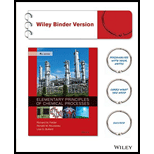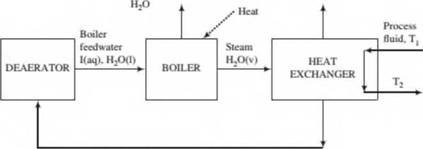
Boilers are used in most chemical plants to generate steam for various purposes, such as to preheat process streams fed to reactors and separation units. In one such process, steam and a cold process fluid are fed to a heat exchanger where enough energy is transferred from the steam to cause a large fraction of it to condense. The uncondensed steam is vented to the atmosphere, and the liquid condensate is recycled to a deaerator into which another liquid stream (makeup water) is fed. The makeup water contains some dissolved impurities and other chemicals that help prevent deposition of solids on boiler walls and heating elements, which would lead to a reduction in operating efficiency and eventually to safety hazards, possibly including explosions. The liquid leaving the deaerator is the feed to the boiler. In the boiler, most of the water in the feed evaporates to form steam, and some of the impurities in the feedwater precipitate to form solid particles suspended in the liquid (kept in suspension by the chemical additives in the makeup w ater). The liquid and suspended solids are drawn oft' as boiler blowdown, either in manual bursts or w ith a continuous blowdown system.
A diagram of the system is shown below. The symbol I is used for combined impurities and chemical additives. The makeup water contains 1.0 kg 1/2.0 X 103 kg HjO, and the ratio in the blowdown is 1.0 kg 1/3.5 X 102 kg HiO. Of the steam fed to the heat exchanger, 76% is condensed.

- In your own words, describe why makeup water, chemical additives to the makeup water, and blowdown are necessary in this process. Speculate on the probable disadvantage of making the 1/HsO ratio in the blowdown (I) too small, and (ii) too large.
- Assume a basis of calculation and draw and fully label a flow chart of the process. (When you draw the heat exchanger you can omit the process fluid, which plays no role in the problem.)
- Carry out a degree-of-freedom analysis and outline a solution procedure (which equations would you write in which order to calculate all of the unknow ns on the chart?).
(d, Calculate the ratio (mass of makeup water/lOOkg steam produced in boiler) and the percentage of the boiler feedwater taken off as blowdown.
(c) A proposal has been made to use highly purified water as makeup. List the benefits that would result from doing so and the most likely reason for not doing it.
Want to see the full answer?
Check out a sample textbook solution
Chapter 4 Solutions
Elementary Principles of Chemical Processes, Binder Ready Version
Additional Engineering Textbook Solutions
Starting Out with Python (4th Edition)
Concepts Of Programming Languages
Java How to Program, Early Objects (11th Edition) (Deitel: How to Program)
Management Information Systems: Managing The Digital Firm (16th Edition)
INTERNATIONAL EDITION---Engineering Mechanics: Statics, 14th edition (SI unit)
Modern Database Management
- Problem 1 Marks: 60 Section: 1a): 30 marks, Section 1b):30 marks A laboratory scale fluidized bed is considered for studying a catalytic ozone decomposition. a) It is requested to derive model equations under the following assumptions: ■ Operation of the catalytic reactor under steady state conditions, There is no influence of thermal ozone decomposition reactions. The fluidized bed includes bubbles and dense phase. □ The dense phase can be simulated using a CSTR The fluidized bed bubbles contain catalyst particles and can be simulated as a DSTR (batch). □ The jets contain particles and can be simulated with a PFR. The influence of the freeboard has to be considered using a PFR model. The available catalytic reaction rate model is r (moles/gcat.s)= -k CA b) Same than on a) under unsteady state conditions, using an absorbable and reactive tracer. Note: A step-by step derivation of the model equations is required here. A quick answer will not do. Problem 2 Marks: 40 Section 2a: 30 marks,…arrow_forwardPenicillin process Penicillium chrysogenum is used to produce penicillin in a 90,000-litre fermenter. The volumetric rate of oxygen uptake by the cells ranges from 0.45 to 0.85 mmol l^−1 min^−1 depending on time during the culture. Power input by stirring is 2.9 W l^−1. Estimate the cooling requirements.arrow_forwardProduction of bakers’ yeast Bakers’ yeast is produced in a 50,000-litre fermenter under aerobic conditions. The carbon substrate is sucrose; ammonia is provided as the nitrogen source. The average biomass composition is CH_1.83O_0.55N_0.17 with 5% ash. Under conditions supporting efficient growth, biomass is the only major product and the biomass yield from sucrose is 0.5 g g^−1. If the specific growth rate is 0.45 h^−1, estimate the rate of heat removal required to maintain constant temperature in the fermenter when the yeast concentration is 10 g l^−1.arrow_forward
- Sensible energy change Calculate the enthalpy change associated with the following processes:(a) m-Cresol is heated from 25°C to 100°C(b) Ethylene glycol is cooled from 20°C to 10°C(c) Succinic acid is heated from 15°C to 120°C(d) Air is cooled from 150°C to 65°Carrow_forward▼ Enzyme conversion An immobilised enzyme process is used in an ice-cream factory to hydrolyse lactose (C12H22O11) to glucose (C6H12O6) and galactose (C6H1206): C12H22O11 + H2O →→ C6H12O + C6H12O6 Gel beads containing ß-galactosidase are packed into a column reactor; 2500 kg of lactose enters the reactor per day as a 10% solution in water at 25°C. The reactor operates at steady state and 32°C; all of the lactose is converted. Because the heat of reaction for enzyme conversions is not as great as for cell culture, sensible heat changes and heats of mixing cannot be ignored. Lactose Water Ah (kJ gmol¹) C, (cal g¹ ºC-¹) Ahm (kcal gmol¹) 3.7 -5652.5 0.30 1.0 Glucose -2805.0 0.30 5.6 Galactose -2805.7 0.30 5.6 (a) What is the standard heat of reaction for this enzyme conversion? (b) Estimate the heating or cooling requirements for this process. State explicitly whether heating or cooling is needed.arrow_forwardBacterial production of alginate Azotobacter vinelandii is investigated for production of alginate from sucrose. In a continuous fermenter at 28°C with ammonia as nitrogen source, the yield of alginate was found to be 4 g g^−1 oxygen consumed. It is planned to produce alginate at a rate of 5 kg h^−1. Since the viscosity of alginate in aqueous solution is considerable, energy input due to mixing the broth cannot be neglected. The fermenter is equipped with a flat-blade disc turbine; at a satisfactory mixing speed and air flow rate, the power requirements are estimated at 1.5 kW. Calculate the cooling requirements.arrow_forward
- Preheating nutrient medium Steam is used to heat nutrient medium in a continuous-flow process. Saturated steam at 150°C enters a coil on the outside of the heating vessel and is completely condensed. Liquid medium enters the vessel at 15°C and leaves at 44°C. Heat losses from the jacket to the surroundings are estimated as 0.22 kW. If the flow rate of medium is 3250 kg h^−1 and its heat capacity is 0.9 cal g^−1 °C^−1, how much steam is required?arrow_forwardQ3] Determine the optimal operating conditions (XA, t, and CR) in a mixed flow reactor to maximize the concentration of R (CR) in the effluent, where an aqueous feed A with an initial concentration of CA0-40 mol/m³ enters the reactor, undergoes decomposition, and exits as a mixture containing A, R, and S. K₁ AR, FR = k₁C, k₁ = 0.4 m³/(mol min) SA AS, rs = k₂CA, k₂ = 2(min), CA0 = 40 mol/m³arrow_forwardConsider the parallel decomposition of A of different orders with FR = 1, rs = 2CA and IT = C. Determine the maximum concentration of desired product obtainable in mixed flow reactor and plug flow reactor. (1) R is desired product and CA0 = 2. (2) S is desired product and CA0 = 4. R S Tarrow_forward
- 1. Copper is known to be toxic to fish, and in particular, the free ion Cu²+ species typically shows greatest toxicity. a. Calculate the speciation of Cu(II) for freshwater at a pH value of 8.3 as the hardness increases from 20 (soft) to 100 (moderately hard) to 200 (very hard) mg/L as CaCO3. Assume that the total divalent Cu(II) concentration is 10 µg/L. b. Based on your findings in part (a), do you think it is appropriate to set a single regulatory limit or should it depend on variables such as pH and hardness? Explain your answer.arrow_forwardMaterial Sciencearrow_forwardElectronic devices found in integrated circuits are composed of very high purity silicon to which has been added small and very controlled concentrations of elements found in Groups IIIA and VA of the periodic table. For Si that has had added 9.1 × 1021 atoms per cubic meter of antimony compute (a) the weight percent and (b) the atom percent of Sb present. (Hint: use Equation 100 C₁ = 1 + NAP2 N1A₁ P2 P1 (a) 0.00636 %wt (b) i 0.0182 %atarrow_forward
 Introduction to Chemical Engineering Thermodynami...Chemical EngineeringISBN:9781259696527Author:J.M. Smith Termodinamica en ingenieria quimica, Hendrick C Van Ness, Michael Abbott, Mark SwihartPublisher:McGraw-Hill Education
Introduction to Chemical Engineering Thermodynami...Chemical EngineeringISBN:9781259696527Author:J.M. Smith Termodinamica en ingenieria quimica, Hendrick C Van Ness, Michael Abbott, Mark SwihartPublisher:McGraw-Hill Education Elementary Principles of Chemical Processes, Bind...Chemical EngineeringISBN:9781118431221Author:Richard M. Felder, Ronald W. Rousseau, Lisa G. BullardPublisher:WILEY
Elementary Principles of Chemical Processes, Bind...Chemical EngineeringISBN:9781118431221Author:Richard M. Felder, Ronald W. Rousseau, Lisa G. BullardPublisher:WILEY Elements of Chemical Reaction Engineering (5th Ed...Chemical EngineeringISBN:9780133887518Author:H. Scott FoglerPublisher:Prentice Hall
Elements of Chemical Reaction Engineering (5th Ed...Chemical EngineeringISBN:9780133887518Author:H. Scott FoglerPublisher:Prentice Hall
 Industrial Plastics: Theory and ApplicationsChemical EngineeringISBN:9781285061238Author:Lokensgard, ErikPublisher:Delmar Cengage Learning
Industrial Plastics: Theory and ApplicationsChemical EngineeringISBN:9781285061238Author:Lokensgard, ErikPublisher:Delmar Cengage Learning Unit Operations of Chemical EngineeringChemical EngineeringISBN:9780072848236Author:Warren McCabe, Julian C. Smith, Peter HarriottPublisher:McGraw-Hill Companies, The
Unit Operations of Chemical EngineeringChemical EngineeringISBN:9780072848236Author:Warren McCabe, Julian C. Smith, Peter HarriottPublisher:McGraw-Hill Companies, The





